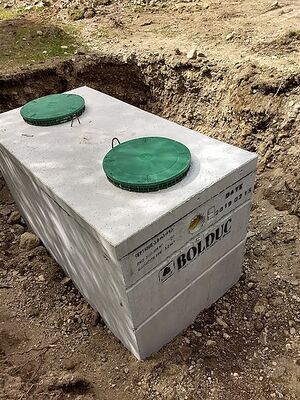Septic system
A septic system is a self-contained, off grid method for treating black water. It is a common alternative to municipal sewage systems in rural areas. Septic systems typically comprise of a two compartment septic tank and a drain field. Properly maintained, septic systems are highly efficient.
The septic tank is a watertight box, usually made of concrete or fiberglass, with an inlet and outlet pipe. Wastewater flows from the home to the septic tank through the sewer pipe. The septic tank treats the wastewater naturally by holding it in the tank long enough for solids and liquids to separate. The wastewater forms three layers inside the tank. Solids that float in water, such as greases and oils, form a layer of scum on top. Solids that sink in water settle at the bottom of the tank forming a layer of sludge. This leaves a middle layer of partially clarified wastewater.
The layers of sludge and scum remain in the septic tank where bacteria found naturally in the wastewater work to break the solids down. The sludge and scum that cannot be broken down are retained in the tank until the tank is pumped. The layer of clarified liquid flows from the septic tank to the drainfield or to a distribution device, which helps to uniformly distribute the wastewater in the drainfield. A standard drainfield is a series of trenches or a bed lined with gravel or course sand and buried one to three feet below the ground surface. Perforated pipes or drain tiles run through the trenches to distribute the wastewater. The drainfield treats the wastewater by allowing it to slowly trickle from the pipes out into the gravel and down through the soil. The gravel and soil act as biological filters.
Maintenance
A septic system must be properly maintained to work correctly. How often you need to pump the solids out of your septic tank depends on three major factors:
- the number of people in your household;
- the amount of wastewater generated (based on the number of people in the household and the amount of water used); and,
- the volume of solids in the wastewater (e.g., using a garbage disposal will increase the amount of solids).
Although your septic tank absorption field generally does not require maintenance, you should adhere to the following rules to protect and prolong its functional life:
- Do not drive over the absorption field with cars, trucks, or heavy equipment.
- Do not plant trees or shrubbery in the absorption field area, because the roots can get into the lines and plug them.
- Do not cover the absorption field with hard surfaces, such as concrete or asphalt. Grass is the best cover, because it will help prevent erosion and help remove excess water.
- Do divert surface runoff water from roofs, patios, driveways, and other areas away from the absorption field.
Homeowners wanting to take good care of their septic systems should make note of the following items that should never be flushed down the drain or toilet. These items can overtax or destroy the biological digestion taking place within the system or clog pumps and pipes.
Take care not to flush the following:
- hair combings
- coffee grounds
- dental floss
- disposable diapers
- kitty litter
- sanitary napkins
- tampons
- cigarette butts
- condoms
- gauze bandages
- fat, grease, or oil
- paper towels
NEVER flush chemicals that could contaminate surface and groundwater, such as:
- paints
- varnishes
- thinners
- waste oil
- photographic solutions
- pesticides
Links
- Septic system on a hill - YouTube
- Septics 101 - YouTube
